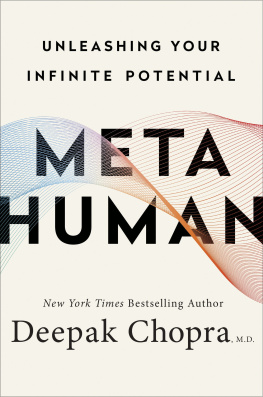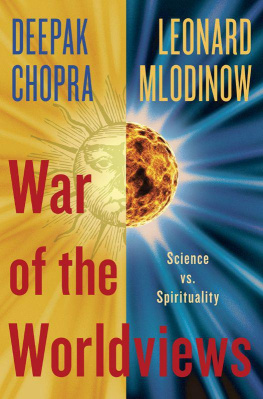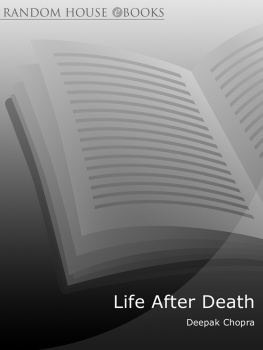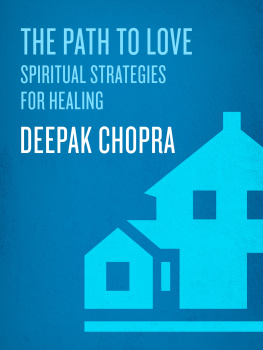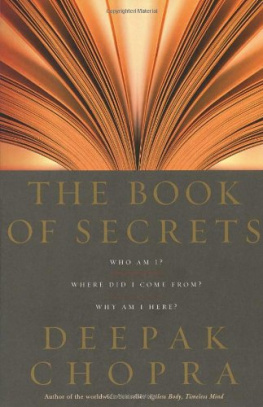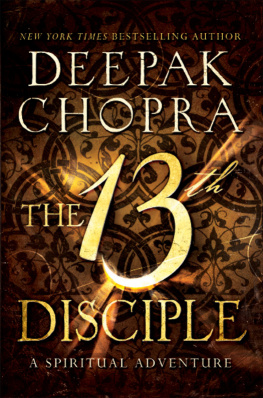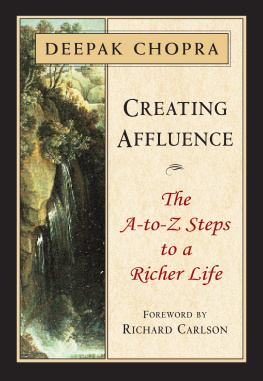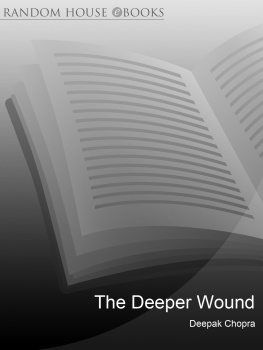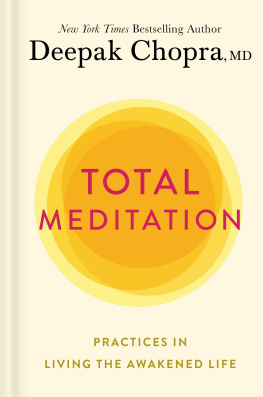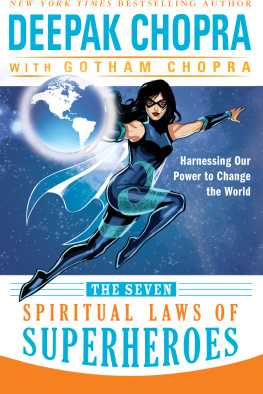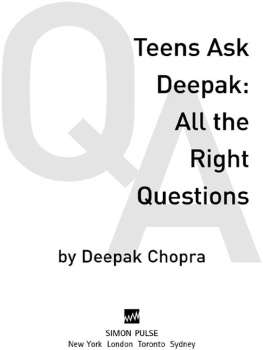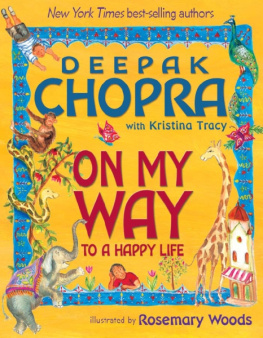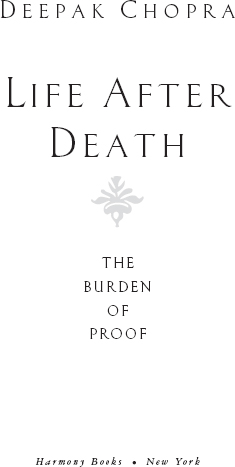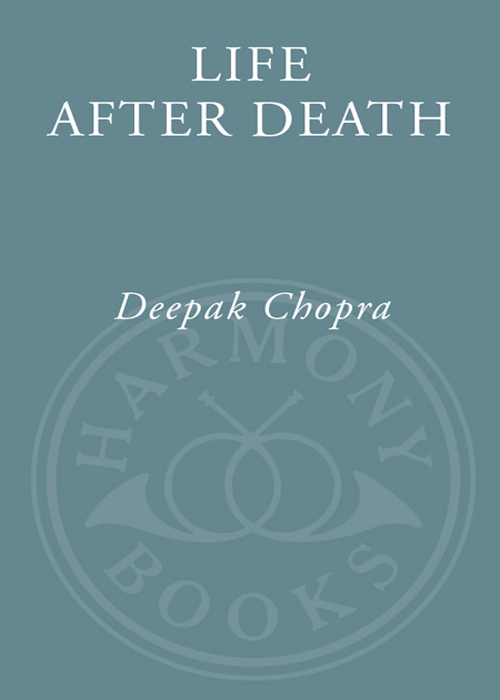
CONTENTS
To my beloved parents
ACKNOWLEDGMENTS
My longtime editor, Peter Guzzardi, encouraged me to write a book on death and dying, which evolved into this book. As always, his instincts were astute, and he has been an invaluable guide every step of the way.
To David, Carolyn, Felicia, and the entire staff at the Chopra Center, I am reminded every day of your dedication and kindness to me. Thank you.
To my family, who gives me more loving devotion than I could ever return in a lifetime.

MEMOIR: THE LIFE BEYOND
WHILE WRITING THIS book on the afterlife, I kept being drawn back to stories that Id heard in India as a child. Parables are a powerful way to teach children, and many of the ones told to me have lasted all my life. So I decided to weave the book around tales of the kind I heard at home, around the temples, and at school, hoping that the reader would be enticed by a world where heroes battle darkness in order to emerge into the light.
In this case the hero is a woman, Savitri, and the enemy she must defeat is Yama, the Lord of Death. Yama shows up in her front yard one day, waiting to take away her husband the moment he returns from his work as a woodcutter. Savitri is terrified. What strategy could possibly turn Death away from his inexorable mission?
I had no trouble imagining these characters. I was frightened for Savitri and anxious to find out how her battle of wits with Death turned out. Their world flowed easily into my own, because the India of my childhood was not that far removed from ancient India. I want to take a moment to convey what death and the world beyond meant back then. It may seem like a very esoteric place. If so, you can come back to it after reading the main body of the book. However mysterious and exotic, here is where I began.
What was most magical in my childhood was transformation. Death itself was seen as a brief stopping point on an endless soul journey that could turn a peasant into a king and vice versa. With the possibility of infinite lifetimes extending forward and backward, a soul could experience hundreds of heavens and hells. Death ended nothing; it opened up limitless adventures. But at a deeper level, its typically Indian not to crave permanence. A drop of water becomes vapor, which is invisible, yet vapor materializes into billowing clouds, and from clouds rain falls back to earth, forming river torrents and eventually merging into the sea. Has the drop of water died along the way? No, it undergoes a new expression at each stage. Likewise, the idea that I have a fixed body locked in space and time is a mirage. Any drop of water inside my body could have been ocean, cloud, river, or spring the day before. I remind myself of this fact when the bonds of daily life squeeze too tight.
In the West the hereafter has been viewed as a place akin to the material world. Heaven, hell, and purgatory lie in some distant region beyond the sky or under the earth. In the India of my childhood the hereafter wasnt a place at all, but a state of awareness.
The cosmos that you and I are experiencing right now, with trees, plants, people, houses, cars, stars, and galaxies, is just consciousness expressing itself at one particular frequency. Elsewhere in spacetime, different planes exist simultaneously. If I had asked my grandmother where heaven was, she would have pointed to the house we lived in, not only because it was full of love, but because it made sense to her that many worlds could comfortably inhabit the same place. By analogy, if you are listening to a concert orchestra, there are a hundred instruments playing, each occupying the same place in space and time. You can listen to the symphony as a whole or, if you wish, put your attention on a specific instrument. You can even separate out the individual notes played by that instrument. The presence of one frequency does not displace any of the others.
I didnt know it as a child, but when I walked around the crowded Delhi market where more humanity was packed into one bazaar than was possible to imagine, the world I couldnt see was even more crowded. The air that I breathed contained voices, car noises, bird songs, radio waves, X-rays, cosmic rays, and an almost infinite array of subatomic particles. Endless realities lay all around me.
Every frequency in nature exists simultaneously, and yet we experience only what we see. Its natural to fear what we cant see, and since death snatches a person out of sight, we react to it with fear. I certainly wasnt immune to this. The death of a pet made me anxious and sad; the death of my grandfather, which happened suddenly in the middle of the night, was devastating. My younger brother kept running around the house crying, Where is he? Where is he? It would be years before I realized that the correct answer was Here and everywhere.
Different planes of existence represent different frequencies of consciousness. The world of physical matter is just one expression of a particular frequency. (Decades later, I was fascinated to read that according to physicists, there is a background hum to the universe that is so specific as to sound like the note B-flat, although it vibrates millions of times lower than human hearing.) In India a child would never hear such a complicated quasi-scientific idea, but I did hear about the five elements, or Mahabhutas: earth, water, fire, air, and space. These elements combined to form everything in existence, which sounds crude to someone versed in Western science, but it contained a valuable truth: All transformations come down to a few simple elements.
In the twentieth century Western science came to understand that all solid objects are actually made of invisible vibrations. In my childhood, solid things were seen to have a large portion of the earth element. To put it another way, solid things had dense vibrations, or vibrations on a lower plane. Vaporous things had a fine vibration, on a higher plane.
Just as there are different planes of material things, there are also different spiritual planes, a shocking notion to the pious Catholic brothers, mostly Irish, who were my teachers at school. To them the only spirit was the Holy Ghost that lived in heaven. We children were politic enough not to disagree, yet in our cosmos it only made sense that if the Earth was a dense spiritual world, there must be higher spiritual planes, known to us as Lokas, which in Western mystical circles became known as astral planes. There are an almost infinite number of astral planes, divided into a higher and lower astral world, and even the lowest ones vibrate at a higher frequency than the material world.
Long ago the West gave up trying to hear the music of the spheres, but in India it is believed that a person with finely tuned consciousness can go inward and actually hear the vibration of various higher planes. In the astral plane you can see your own body, for instance, yet it might change in age from moment to moment.
In the lower astral planes we find clairvoyance, telepathy, and other refinements of the five senses, as well as ghosts, disembodied souls, and spirits that for one reason or another are stuck. As a child I was certain that when a cat or dog paused to assess the air, it saw something I couldnt. So it came as no surprise to later read, in various texts both Eastern and Western, that lower astral planes sometimes sensed by humans in higher states of awareness are often sensed by animals. Nor was I surprised to meet a psychiatry resident who told me that if the hospital room was dimly lit enough, he could seeon the very edge of visibilitywhen the soul left a dying person. Every Indian child devours comic books about the exploits of various heroes who fought their battles in faraway Lokas. Slipping in and out of material existence was our version of traveling to outer space. Our comic book heroes would come across thought forms and thought clouds, astral bodies traveling during sleep, astral colors and auras. All these are vibrations in the lower astral plane.
Next page

